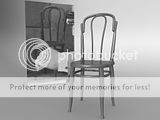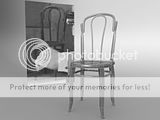Here is an overlay of your scene and the reference image with some notes on things I think you may want to adjust.
1-4] there is a pillar, molding, board (I think), and sign on the wall to the far left.
5] stool and table against far wall seem to tall.
6] second level of the table on the far wall seems thicker in the reference
7] the hinge at the back of the desk lamp is missing
8] overall scale of the scene is taller then the reference and some of the scaling issues may be caused by perspective based on focal length and position of the locked down camera for the scene. The things circled in green show the camera angle discrepancy between your scene and the reference image. You can see the windows, the board on the far wall, the lights, the stool, ..., are all stretched up and shifted left.
9] books missing
10] little nits - There is also what looks to be a coffee or tea pot, cup, and container on the lhs of the table on the far wall that need to be modeled. They are all pretty simple shapes though.
It's a very good start with proxy quality models. You will need to add some bevels to avoid the razor sharp CG looking edges. Very little in nature is razor sharp and razor sharp edges are the very first thing that give away CG images.
Your blocking out of the shapes though and scale, with the exception of the couple things mentioned above is a very good start though.

perfecto on this site has done some magnificent work modeling a home office scene and he includes lots of wire frame shots so you can see how his models are built and bevels were done.
check out his wip link here https://srv01.simply3dworld.com/showt...threadid=33604
"If I have seen further it is by standing on the shoulders of giants." Sir Isaac Newton, 1675
Last edited by ctbram; 07-02-2010 at 07:31 PM.






